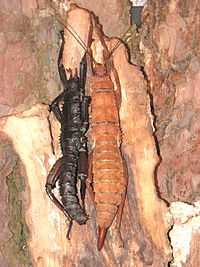Phasmatidae
| Phasmatidae | |
|---|---|
 | |
| Eurycanthinae: Eurycantha calcarata (male left, female right) | |
| Scientific classification | |
| Kingdom: | Animalia |
| Phylum: | Arthropoda |
| Class: | Insecta |
| Order: | Phasmatodea |
| Suborder: | Verophasmatodea |
| Superfamily: | Anareolatae |
| Family: | Phasmatidae Roberts, 1944 |
| Diversity | |
| 9 subfamilies (but see text) | |
| Synonyms | |
|
Phasmidae Gray, 1835 | |
Phasmatidae is a family of the stick insects (order Phasmatodea). They belong to the superfamily Anareolatae of suborder Verophasmatodea.[1]
Like many of their relatives, Phasmatidae are capable of regenerating limbs and commonly reproduce by parthenogenesis. Despite their bizarre, even threatening appearance, they are harmless to humans.
The Phasmatidae contain some of the biggest insects currently in existence. The recently discovered Chan's Megastick (Phobaeticus chani) of the Clitumninae (sometimes placed in Phasmatinae) can grow to a total length of over half a meter (20 in); it is the longest living insect known at present.
Subfamilies
Here, following the Phasmid Study Group, nine subfamilies are recognized in the Phasmatidae. Other treatments differ, sometimes recognizing as few as six.[1]
The Lonchodinae were historically often placed in the Diapheromeridae, the other family of the Anareolatae. The Phasmatinae are often expanded to include the two tribes here separated as Clitumninae, while the Extatosomatinae are similarly included in the Tropidoderinae as a tribe.
The subfamilies are:[1]
- Cladomorphinae
- Clitumninae (sometimes in Phasmatinae)
- Eurycanthinae – land lobsters
- Extatosomatinae (sometimes in Tropidoderinae)
- Lonchodinae (sometimes in Diapheromeridae)
- Phasmatinae (sometimes includes Clitumninae)
- Platycraninae
- Tropidoderinae (sometimes includes Extatosomatinae)
- Xeroderinae
In addition, there are a number of Phasmatidae taxa here considered incertae sedis:[1]
- Tribe Achriopterini (sometimes in Phasmatinae)
- Tribe Stephanacridini (sometimes in Phasmatinae)
- Genus Monoiognosis
- Genus Spathomorpha

See also
References
- ↑ 1.0 1.1 1.2 1.3 "Phasmatidae". Phasmida SpeciesFile. Phasmid Study Group. September 28, 2009. Retrieved April 19, 2011.
- ↑ "World's Longest Insect Revealed". Natural History Museum. 16 October 2008.
Further reading
- Balderson, J., Rentz, D.C.F. and Roach, A.M.E. (1998). in Houston, W.K.K. & Wells, A. (1998) (eds) Zoological Catalogue of Australia. Vol. 23. Melbourne: CSIRO Publishing, Australia. pp. 347-376.
- Bradley, J.C., and Galil, B.S. (1977). The taxonomic arrangement of the Phasmatodea with keys to the subfamilies and tribes. Proceedings of the Entomological Society of Washington, 79(2): 176-208.
- Gurney, A.B. (1947). Notes on some remarkable Australasian walkingsticks, including a synopsis of the Genus Extatosoma (Orthoptera: Phasmatidae). Annals of the Entomological Society of America. 40(3): 373-396.
- Key, K.H.L. (1970). Phasmatodea (Stick-insects). pp. 394-404 in CSIRO (ed.) The Insects of Australia. Melbourne: Melbourne University Press, Vol. 1.
- Kirby, W.F. (1904). A Synonymic Catalogue of Orthoptera. 8vo. Vol. 1. Orthoptera, Euplexoptera, Cursoria, et Gressoria (Forficulidæ, Hemimeridæ, Blattidæ, Mantidæ, Phasmidæ). London: Longmans & Co. x 501 pp.
- Latreille, P.A. (1817). Volume 3: Les Crustacés, Les Arachnides et Les Insectes, Cuvier, G.L.C.F.D. (1817). Le Régne Animal. Paris.
- Rentz, D.C.F (1996). Grasshopper Country, Chapter 16, Phasmatodea: Leaf and Stick Insects, pp. 244-257.
External links
| Wikimedia Commons has media related to Phasmatidae. |
| Wikispecies has information related to: Phasmatidae |
| ||||||||||||||||||||||||||||||